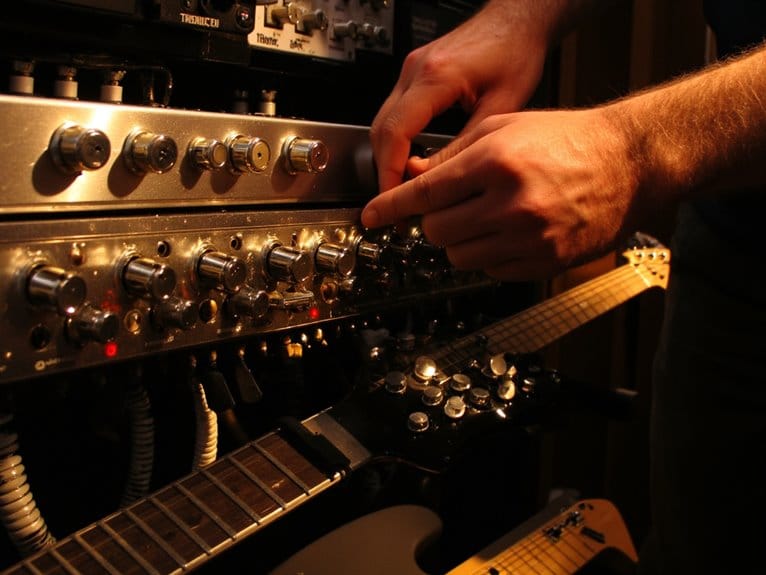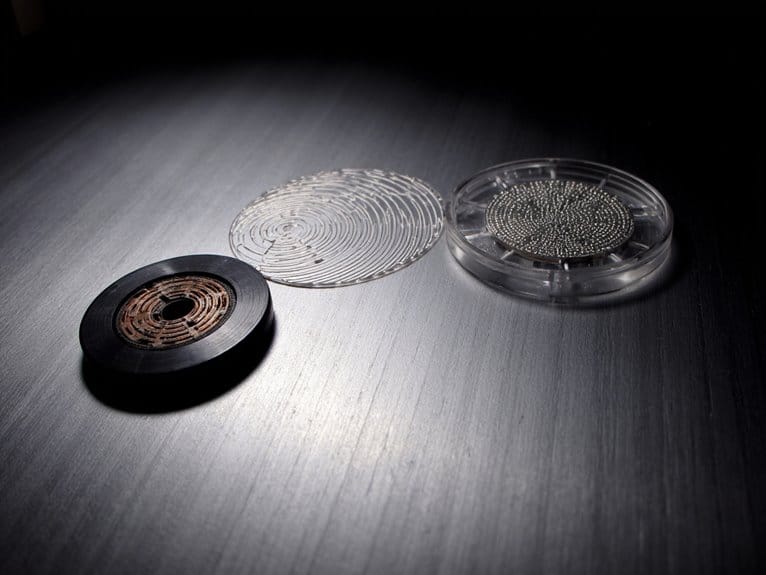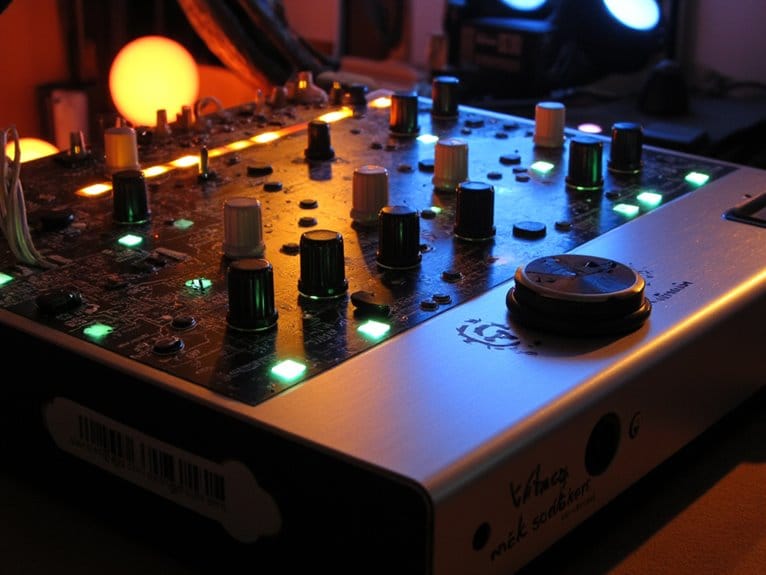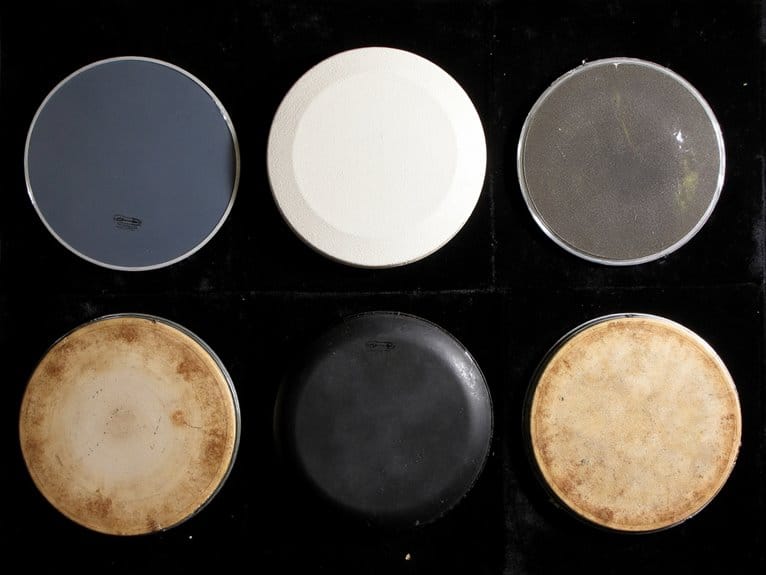Understanding Bass Guitar Compression and Its Uses
Bass guitar compression acts as automatic volume control that tames your dynamic swings, ensuring soft fingerpicked notes don’t get buried while aggressive slaps don’t overpower the mix. You’ll typically use 2:1 to 4:1 ratios with 20-40ms attack times to preserve essential transients, while release times should match your song’s tempo for natural flow. Different genres demand varying approaches—jazz requires gentle 2:1-3:1 settings for transparency, while rock uses 4:1-6:1 for consistent presence, and metal employs extreme ratios for tight control that maintains rhythmic drive and enhances your bass’s sonic character throughout complex arrangements.
We are supported by our audience. When you purchase through links on our site, we may earn an affiliate commission, at no extra cost for you. Learn more.
Notable Insights
- Bass guitar compression acts as automatic volume control, taming dynamic swings to maintain balance between loud and soft notes.
- Key parameters include threshold (compression trigger point), ratio (reduction amount), attack time (engagement speed), and release time (recovery duration).
- Compression ratios vary by genre: 2:1-3:1 for jazz transparency, 4:1-6:1 for rock/pop control, and 6:1+ for aggressive metal sounds.
- Benefits include consistent dynamics across playing techniques, enhanced mix presence, improved tonal character, and creative sound shaping capabilities.
- Common mistakes include over-compression causing lifeless tone, incorrect attack times destroying transients, and improper release settings creating pumping artifacts.
What Is Bass Guitar Compression and How Does It Work
Bass guitar compression, at its core, functions as an automatic volume control that tames the wild dynamic swings inherent in your instrument’s signal, ensuring that thunderous low notes don’t overpower delicate fingerpicked passages while preventing softer notes from disappearing entirely into the mix.
Understanding compression fundamentals starts with grasping how the compressor monitors your signal through its sidechain circuit, which triggers gain reduction when your playing exceeds a predetermined threshold level. The knee setting provides additional control by adjusting how smoothly compression engages around the threshold point, with higher knee values creating a more gradual transition into compression.
This dynamic control process involves several key parameters: the ratio determines how much volume reduction occurs, typically ranging from 2:1 to 4:1 for bass applications, while attack and release times control how quickly the compressor responds to signal peaks and returns to normal operation, respectively. The compressor’s ability to enhance articulation helps the bass guitar cut through dense mixes while maintaining its foundational role in the rhythm section.
Setting the Right Threshold and Ratio for Your Bass
Two critical controls determine how effectively your compressor shapes your bass tone: threshold and ratio, which work together like a tag team to control when compression kicks in and how aggressively it responds once triggered. Understanding threshold importance starts with recognizing it sets the signal level where compression begins—signals below remain untouched, while everything above gets processed. The ratio impact determines how much volume reduction occurs once you’ve crossed that threshold line.
| Ratio Setting | Compression Style | Best Use Case |
|---|---|---|
| 2:1-3:1 | Gentle/Transparent | Jazz, acoustic settings |
| 4:1-6:1 | Moderate Control | Rock, pop mixes |
| 6:1-8:1 | Aggressive/Present | Dense arrangements |
| 8:1+ | Limiting Territory | Peak control |
| Variable | Dynamic Response | Complex arrangements |
Start with moderate ratios around 4:1, then adjust threshold until you’re compressing consistently without squashing your bass’s natural character completely. Many bassists find that optical compression provides a smoother, more musical response when dialing in these critical settings. Position your threshold around the quietest played note on your bass to achieve effective control over your entire dynamic range.
Dialing In Attack and Release Times
Once you’ve nailed your threshold and ratio settings, the real magic happens when you start manipulating attack and release times, two parameters that’ll make or break how your bass breathes and punches through a mix.
Attack time controls how quickly compression kicks in after your signal crosses the threshold, while release time determines how long the compressor holds onto that gain reduction. I typically start with around 100ms attack time to preserve those essential transients that give your bass its punch, then dial in a faster release between 1-100ms to maintain natural sustain.
Attack and release times are the secret weapons that determine whether your bass punches through the mix or gets lost in compression limbo.
- Start with 100ms attack and fast release as your baseline settings
- Slow attack preserves transients; fast attack smooths out aggressive playing
- Match release time to your song’s tempo for natural dynamic flow
- Watch gain reduction meters to time compression recovery between notes
- Balance punch retention against dynamic control based on your mix needs
Just like with budget reverb pedals that feature true bypass circuitry to maintain signal integrity, your compressor’s bypass functionality should preserve your bass tone when the effect is disengaged.
Hard Knee Vs Soft Knee Compression Characteristics
The knee setting on your compressor determines how abruptly or smoothly compression engages when your signal hits the threshold, and I’ve found this choice dramatically affects whether your bass sounds naturally controlled or aggressively processed. Hard knee compression applies full compression immediately once you cross the threshold, creating obvious pumping effects that work brilliantly for percussive bass lines or aggressive rock tones. Soft knee compression gradually increases the ratio as your signal approaches the threshold, delivering transparent dynamic control that preserves your bass’s natural expressiveness.
| Characteristic | Hard Knee | Soft Knee |
|---|---|---|
| Engagement | Immediate, abrupt shift | Gradual, smooth shift |
| Audibility | Obvious compression artifacts | Transparent, natural sound |
| Best Applications | Drums, aggressive bass styles | Vocals, smooth bass tones |
Most compression types offer adjustable knee settings, allowing you to tailor the dynamic control between these extremes.
Benefits of Using Compression on Bass Guitar
While you can certainly play bass without compression, I’ve discovered that adding this essential tool to your signal chain reveals significant advantages that’ll transform both your sound and playing experience.
Different compression types offer distinct benefits across musical genres, from subtle dynamic control in jazz to aggressive punch in rock and metal.
Here’s what compression brings to your bass sound:
- Dynamic consistency – Evens out volume fluctuations between soft fingerstyle passages and aggressive slapping techniques
- Enhanced mix presence – Prevents your bass from disappearing during loud choruses or dense instrumental sections
- Tonal character development – Adds warmth, punch, or grit depending on your compressor choice and settings
- Performance stability – Reduces the need for constant volume adjustments during live performances
- Creative sound shaping – Enables artistic control over attack, sustain, and rhythmic feel
Many modern multi-effects pedals include compression alongside other essential bass effects, offering an all-in-one solution for comprehensive sound control.
Like boost pedals that can provide up to 35dB gain, compression pedals offer varying degrees of control to shape your bass tone according to different musical contexts.
Quality oxygen-free copper conductors in your signal chain ensure that compressed bass signals maintain their clarity and punch without unwanted interference or signal degradation.
Recommended Compression Settings for Different Styles
Five distinct musical styles demand dramatically different compression approaches, and I’ve spent countless hours dialing in the perfect settings for each genre to help you achieve professional-sounding results.
Rock requires aggressive 8:1 ratios with low thresholds, emphasizing energy over dynamics, while jazz demands gentler 2:1-4:1 ratios with higher thresholds to preserve natural expression.
Rock compression sacrifices dynamics for raw power, while jazz compression preserves the subtle nuances that define musical expression.
Metal compression styles utilize extreme settings—nearly zero attack times and infinite ratios—creating that characteristic tight, controlled sound.
Pop sits comfortably in the middle with 4:1-6:1 ratios for consistent presence, whereas funk compression balances articulation with control through moderate 3:1-5:1 settings. For funk bassists seeking additional tone shaping capabilities, a 3-band EQ can provide the midrange control necessary to cut through dense mixes while maintaining that punchy low-end foundation.
These genre influences directly shape your threshold, ratio, attack, and release choices, making stylistic awareness essential for authentic bass tones. Professional monitoring during compression requires precise frequency response to accurately assess the impact of your settings on the bass tone.
When exploring extended-range instruments, 6-string basses offer enhanced harmonic possibilities that benefit from careful compression to manage the wider frequency spectrum and complex chord progressions.
Avoiding Common Bass Compression Mistakes
You’ve probably made these compression mistakes before—I certainly have during my early mixing days—and understanding them will save your bass tracks from sounding lifeless and amateur.
Over-compression remains the most destructive error, systematically crushing the natural dynamics that give your bass its groove and musicality, while incorrect attack times can either swallow vital transients or let unwanted peaks slip through uncontrolled.
Release settings, often overlooked entirely, determine whether your compression sounds smooth and musical or creates distracting pumping artifacts that destroy the pocket your bassist worked so hard to establish.
Over-Compression Kills Dynamics
Although compression can transform your bass tone in remarkable ways, there’s a fine line between enhancing your sound and completely destroying it—and I’ve crossed that line more times than I’d care to admit.
Over-compression kills the life in your bass, creating a flattened, lifeless tone that lacks the punch needed to drive your music forward.
When you apply excessive compression ratios above 8:1 with low thresholds, you’re fundamentally squashing every bit of natural expression from your instrument, causing unwanted compression artifacts that destroy dynamic preservation.
Just as pickup configurations affect your bass’s natural tonal character, improper compression settings can completely alter your instrument’s voice in undesirable ways. Similarly, maintaining signal integrity is crucial when processing your bass signal, as any degradation can compound the negative effects of over-compression. Whether you’re playing through dual pickups or single-coil configurations, excessive compression will mask the natural tonal variations these pickup systems are designed to deliver.
- Use compression ratios between 2:1 and 4:1 for controlled punch without over-flattening
- Set appropriate thresholds that preserve natural volume differences between notes
- Choose soft knee settings for smoother dynamic changes
- Avoid overly fast release times that create pumping artifacts
- Maintain transient clarity to preserve rhythmic drive
Wrong Attack Times
The attack knob on your compressor might seem like a minor detail, but I’ve learned through countless mix disasters that getting this setting wrong can single-handedly destroy your bass tone’s natural character and rhythmic impact.
Setting attack times below 10ms kills those essential transients that give your bass punch and definition, while excessively slow settings above 40ms let dynamic spikes slip through uncontrolled.
I’ve found the sweet spot typically falls between 20-40ms, where you’ll preserve the initial attack while maintaining compression clarity.
The attack time effects vary dramatically based on your playing style—fingerstyle bass benefits from slower attacks to emphasize punch, while aggressive pick playing requires faster settings to smooth out harsh transients.
Ignoring Release Settings
While attack times grab most of the attention in compression discussions, I’ve watched countless bass tracks fall apart because engineers completely ignored the release settings, treating them like an afterthought rather than the groove-defining parameter they actually are.
Your release timing directly controls how the compressor lets go after processing each note, and when you get this wrong, you’ll hear pumping artifacts that destroy your bass’s natural flow. Proper rhythm matching between your release settings and the song’s tempo creates that locked-in groove that makes listeners move.
- Start with 50-100ms release times, then adjust based on your song’s tempo and bass note spacing
- Use gain reduction meters to verify the compressor fully releases before the next transient hits
- Listen in full mix context to guarantee release complements other instruments without creating unwanted pumping
- Employ the “tempo approach” by matching release times to gaps between bass notes for natural changes
- Combine release adjustments with threshold and ratio tweaks for balanced overall compression character
Just like how affordable audio interfaces can achieve professional sound quality under budget constraints, proper release settings can transform your bass compression from amateur to professional without requiring expensive gear upgrades.
Frequently Asked Questions
Should I Use Compression Before or After EQ in My Signal Chain?
You should generally place compression before EQ in your signal chain. This compression order creates consistent dynamics for EQ to shape, prevents boosting uneven peaks, and maintains better control over your overall tone.
Can I Use Multiple Compressors on Bass for Different Frequency Ranges?
You can absolutely use multiple compressors for frequency splitting on bass. Multi band compression lets you target specific ranges independently, controlling low-end sustain while tightening mids without affecting each other’s characteristics.
How Does Bass Compression Affect the Low-End Response in My Mix?
Bass compression improves your mix’s low end clarity by controlling peaks that cause muddiness. It provides dynamic control, tightening bass response so it sits solidly without conflicting with other instruments in your frequency spectrum.
What’s the Difference Between Analog and Digital Compressors for Bass Guitar?
Analog compressors use tube versus solid state circuitry, adding warmth and saturation to your bass tone. Digital compressors offer cleaner transparency. Hardware versus software choice depends on whether you prioritize musical coloration or precise control.
Should Compression Settings Differ Between Fingerstyle and Pick Playing Techniques?
You’ll need different compression settings because fingerstyle dynamics require gentler ratios and slower attacks to preserve natural expression, while pick attack benefits from faster, more aggressive compression to tame harsh transients.
On a final note
You’ve got the tools now to transform your bass tone through compression, though honestly, it’ll take some practice before you stop second-guessing every knob turn. Start conservative with your settings, trust your ears over what looks right on paper, and don’t compress just because you can. When you dial it in properly, compression becomes invisible magic that makes your bass sit perfectly in any mix you’re working on.






